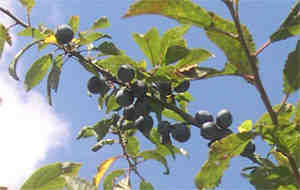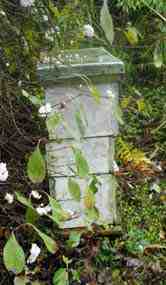The Great Sloe Gin Challenge – Three variations of our sloe gin recipe
Posted by Fiona Nevile in Liqueurs | 162 comments
Beautiful ripe sloes on the bush in September
“Pick after the first frosts,” advise the traditionalists.
“Pick them in September, before the bushes are stripped bare,” chortle the enthusiastic.
“Pick them now and give them a chilly blast in the freezer, to give the effect of the first frost,” suggest the practical.
There are other questions too. If the sloes are left to mature until the first frosts, do they have a better flavour? Does the quality of gin affect the liqueur? Should one strain gin from the sloes after three months, six months, ever?
I telephoned Gilbert to discuss this multiple conundrum. His advice was simple.
“Whatever you do, write it down on a label and stick it on the bottle. Then, if your brew is superb, you have the recipe. Note the tree, the time of picking, the gin and the amount of sugar and sloes. If you used almond essence, note how much on each label.”
I recalled that the most interesting part of his cellar was the vast liqueur wall. The label on each bottle and demijohn was covered in microscopic notes.
“Remember that the combination of gin, sloes and sugar is always better that the separate ingredients, no matter what you do.”
He is right. sloe gin sipped on a cold winter’s night is deliciously dangerous.
We have decided to run The Cottage Smallholder sloe gin test. We are going to make sloe gin now under laboratory conditions in the Cottage Smallholder kitchen. The sloe gin will by tasted and evaluated by a team of three experienced sloe gin drinkers.
Using the same gin (supermarket medium quality) and the same recipe, we are going to make sloe gin with three batches of sloes harvested from the same tree.
- The first bottle will contain freshly picked sloes, picked now in mid September.
- The second will have fresh sloes picked now but which will have had a night in the freezer.
- After the first frosts we are going to return to the same tree with a ladder to collect the frosted sloes that an average height forager can’t reach. The third bottle will contain these.
We will publish are results in a few months time.
Two years later we published the results of the sloe gin recipe challenge.
Sloe Gin Recipe:
Ingredients:
- 1lb/454gm of washed sloes
- 4 ozs/112gm of white granulated sugar
- 1 75cl bottle of medium quality gin
- Sterilised 1 litre (at least) Le Parfait jar or wide necked bottle
- 1 small quarter tsp almond essence
Method:
- Wash sloes well and discard any bruised or rotten fruit. Prick fruit several times with a fork and place sloes in either a large Kilner/Le Parfait jar or a wide necked 1 litre bottle. I put several sloes in my palm to prick them rather than picking them up one by one.
- Using a funnel, add the sugar and top up with gin to the rim. Always open sugar bags over the sink as sugar tends to get caught in the folds at the top of the bag.
- Add the almond essence.
- Shake every day until the sugar is dissolved and then store in a cool, dark place until you can resist it no longer (leave for at least three months, we usually let it mature for a year).
- Some people strain the grog (through muslin/jelly bag) after 3 months and bottle it, leaving it mature for six months. We usually strain and bottle after a year. We use some beautiful old heine brandy bottles with cork lids. If you are feeling flush Lakeland sell some pretty bottles here. Don’t leave the straining process any longer than a year; leaving the fruit in too long can spoil the liqueur.
For loads more tricks and tips on making sloe gin see the original sloe gin recipe
Leave a reply






Spent the weekend decanting. End result is 6L of the best sloe gin I have ever tasted. Small ammount of residue in each bottle due to the fact that I pressed the mash by “wringing” inside a large towel. In doing so I got a further 1L….Happy days 😉
Been making SG for around 5yrs and now am upping my volume as my 25yr old son has discovered a taste for it also. His input runs to supplying gin so all is not lost:)This season I have gone for a 50/50 mix of sloe and damson. Seems to be a little “thicker” than usual but will continue stirring each day and update when I decant in late spring.
fantastic – thanks for your advice – I shall just have to be patient!
I have just tasted my sloe gin. I made it in September to the receipe recommended by the cottage smallholder site – sloes, sugar and a tiny drop of almond
I froze the sloes overnight, then pricked them and then added all the ingredients – and not the cheapest gin either.
Its very TART indeed – nice, but not drinkable as it made my mouth go all … ooh!
I’ve read that you can drink in 3 months – but not this! Shall I ignore it for a year?
Second question, I also made raspberry vodka. I am not a vodka drinker usually and have never made the raspberry version before. It tastes NICE! when is it officially drinkable?
Thanks
Hi Diana
You can add more sugar to the sloe gin. Better to have it too tart than too sweet! I reckon that it’s best to wait at least six months for sloe gin. You can drink it at three months but it tastes ‘young’.
Raspberry vodka – again I’d say leave it for six months. However we have drunk it after three and it was fine.
Managed to go back and pick another pound and a bit so I now have 2 pounds – and I have the rum! I have put the fruit in the freezer as I like the idea of not sitting for an hour pricking the fruit. I plan to try half in dark rum and half in white rum, so I will update and say how it tastes some time next year.
I’ve just been up to my local woods in North London and picked nearly a pound (I have to go back to make it a full pound!) of the final sloes of this year. There were quite a lot left considering I picked my first batch back at the end of August. I tried the cider (slider) and sherry – although I used English fortified wine – ideas and have to say they worked out brilliantly. I have just read about the rum idea too and being a rum drinker I am keen to give it a try, but that may have to wait for next year as I already have the gin! Also, I did the rosehip syrup on your website yesterday and it is the most beautiful colour and tastes divine so I am going to see if I can find any neighbours with rosehips so I can make more!
Dear Danny & Fiona (& Deb)
Just discovered your website – what an excellent site it is! We make our sloe gin almost exactly to your recipe, except that we use 4.25 oz of sugar. We find that the extra quarter oz makes all the difference. Last November we used frozen sloes from the year before. I was afraid they might have spoiled, but if anything the SG is even better. We left it in the demijohns for about eight months. It’s good…
I see above that this year’s sloes are early. We’d better get out there quick! Not much room in the freezer though, what with the twenty bags of blanched saltmarsh samphire. It’s free and plentiful up here on the Lincolnshire coast.
Cheers,
T & C
Thanks Debbie! I’ve just spent an hour online reading different sloe gin recipes (ow! my head hurts – there are so many) Am I right in saying the basic recipe on this brilliant website has far less sugar than others? It seems to, but trying to convert lbs and ounces into grams ain’t my forte… Will it mean the resulting drink is less ‘powerful’ as well as less sweet? Is it OK to just add a bit more sugar after a few weeks? PS Really pleased with the beautiful colour my gin seems to be going already – roll on Christmas!
I USED WHITE RUM….DARK WOULD BE INTERESTING..MMM
YES I USED OLD BOTTLES WITH SCREW TOPS///NEVER HAD A PROBLEM…GOOD LUCK : )
hi ,is it ok to pick sloes now, to make the sloe gin ..thanks rob